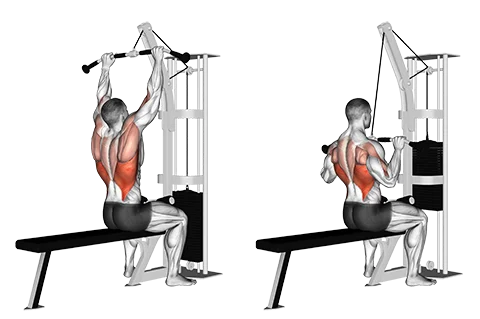Introduction
The cable lat pulldown exercise targets the back muscles, particularly the lats, improving their strength and definition. It's an excellent compound movement that also engages the upper body, including the shoulders and biceps. This exercise is effective in building a strong, functional back, which is crucial for various fitness goals such as improved posture, increased athletic performance, and overall physical well-being.
Muscles Worked
- Primary: Latissimus Dorsi, Rhomboids, Teres Major
- Secondary: Biceps Brachii, Forearm Flexors, Trapezius
How to Do It (Step-by-Step)
- Sit on a lat pulldown machine with your knees slightly bend and your feet flat on the floor. Grab the bar with an overhand grip (palms facing away from you).
- Pull the bar down to your chest by bending your elbows, keeping them close to your body throughout the movement.
- Ensure that your back remains straight, and avoid leaning forward or backward during the exercise. Maintain control over the bar as you return it to the starting position.
Tip: Keep your core engaged throughout the exercise to protect your lower back from strain.
Rep & Rest Guidelines
- Strength: 4–6 reps, 2–3 min rest
- Hypertrophy: 8–12 reps, 60–90 sec rest
- Endurance: 12–20 reps, 30–60 sec rest
To effortlessly track your progress and adjust workouts based on your performance, consider Auto Progression.
For optimal timing of rest periods, utilize the built-in Rest Timer in your workout routine.
Form Tips
- Maintain a straight back and engage your core muscles throughout the exercise.
- Use a wide grip on the bar and pull it down towards your chest, keeping your elbows close to your body.
- Breathe out as you pull the bar down and inhale as you return to the starting position.
When to Use It
- Building a wide and strong back: Cable lat pulldown targets the lats, rhomboids, and lower traps, which are essential for a strong and balanced upper body.
- Improving posture and reducing shoulder pain: This exercise helps correct slouching by strengthening the upper back muscles, which can alleviate tension and discomfort in the shoulders.
- Enhancing athletic performance: Cable lat pulldowns improve the power of your pull and boost your overall strength, beneficial for sports that require pulling movements like rowing, swimming, or gymnastics.
Workout History can help you track your progress over time, ensuring consistent improvement in your fitness journey.
The primary muscle group worked during a cable lat pulldown is the back, specifically the lats. Other muscles engaged include the biceps and forearms.
Stand facing the cable machine with your feet shoulder-width apart. Grab the handle attached to the highest pulley with both hands. Pull the handle down towards your chest while keeping your back straight, squeezing your shoulder blades together at the top of the movement.
Choose a weight that allows you to perform 8-12 repetitions with proper form. Adjust as needed based on your fitness level and goals.
Avoid training the same muscle group daily to prevent overuse injuries. Aim for 2-3 days per week, allowing ample rest in between sessions.
Both exercises target the back muscles, but they engage slightly different muscle fibers due to the mechanics involved. Incorporate both into your routine for well-rounded strength training.

